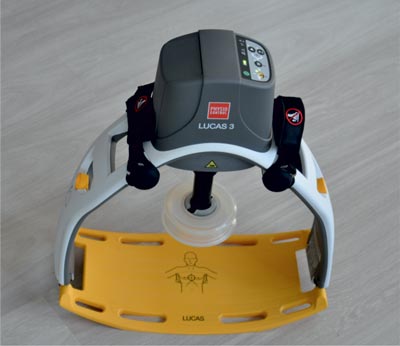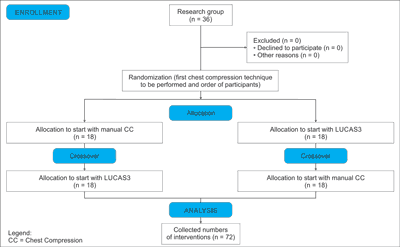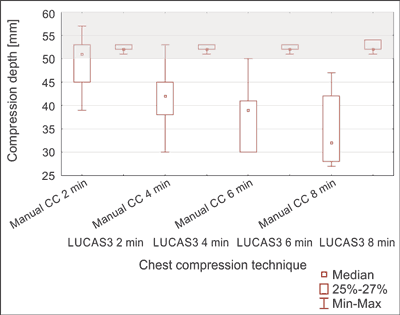Jolanta Majer1, 2, Piotr Zwolinski3, Zuzanna Popielarska3, Dominika Dunder3, Olga Aniolek3, *Marcin Madziala3, Agnieszka Madziala1, 2, Lukasz Szarpak3
Comparison of chest compressions with and without LUCAS3 mechanical chest compression system during resuscitation performed by novice physicians
Porównanie kompresji klatki piersiowej z systemem i bez systemu mechanicznej kompresji klatki piersiowej LUCAS3 podczas resuscytacji wykonywanej przez lekarzy stażystów
1Polish Society of Disaster Medicine, Warsaw, Poland
2Department of Emergency Medical Service, Medical University of Warsaw, Poland
3Lazarski University, Warsaw, Poland
Streszczenie
Wstęp. Wysokiej jakości kompresja klatki piersiowej to jeden z podstawowych elementów wpływających na skuteczność resuscytacji krążeniowo-oddechowej, a tym samym powrót spontanicznego krążenia. W przypadku przedłużającej się resuscytacji bądź gdy prowadzona jest ona przez jedną osobę, jakość kompresji klatki piersiowej może ulec zmniejszeniu. Wówczas pomocne mogą okazać się systemy mechanicznej kompresji klatki piersiowej.
Cel pracy. Celem pracy było porównanie jakości kompresji klatki piersiowej wykonywanej manualnie oraz z zastosowaniem mechanicznego systemu kompresji klatki piersiowej LUCAS3 podczas symulowanej resuscytacji krążeniowo-oddechowej prowadzonej przez lekarzy stażystów.
Materiał i metody. Badanie zaprojektowano jako prospektywne, randomizowane, krzyżowe badanie symulacyjne. W badaniu udział wzięło 36 lekarzy stażystów, którzy mieli za zadanie wykonywanie uciśnięć klatki piersiowej z systemem i bez systemu kompresji klatki piersiowej LUCAS3. Uczestnicy wykonywali uciśnięcia klatki piersiowej w sposób ciągły.
Protokół nadania został zaakceptowany przez Radę Programową Polskiego Towarzystwa Medycyny Katastrof.
Wyniki. Głębokość uciśnięć klatki piersiowej mierzona w 2. minucie resuscytacji z systemem i bez systemu LUCAS3 wynosiła odpowiednio 52 (IQR: 51-53) i 51 (IQR; 45-53) mm, zaś częstość kompresji klatki piersiowej wynosiła 110 (IQR: 105,2-115,2) i 127 (IQR: 102-133) uciśnięć na minutę. W przypadku manualnego uciskania klatki piersiowej niepełna relaksacja klatki piersiowej wynosiła 15 (IQR: 8-21)%, zaś w przypadku systemu LUCAS3 – 0 (IQR: 0-1)%. Poczynając od 4., poprzez 6. i 8. minutę resuscytacji, kompresja klatki piersiowej z wykorzystaniem systemu LUCAS3 w porównaniu z manualnym uciskaniem klatki piersiowej była istotnie statystycznie lepsza (p < 0,05) w odniesieniu do wszystkich analizowanych parametrów kompresji klatki piersiowej (głębokości i częstości kompresji klatki piersiowej, stopnia relaksacji klatki piersiowej oraz punktu ucisku klatki piersiowej).
Wnioski. W przeprowadzonym badaniu symulacyjnym lekarze stażyści, stosując system kompresji klatki piersiowej LUCAS3, wykonywali wyższej jakości kompresję klatki piersiowej aniżeli w przypadku manualnego uciskania klatki piersiowej. Wraz z wydłużeniem czasu trwania resuscytacji zmniejsza się istotnie jakość manualnej kompresji klatki piersiowej.
Summary
Introduction. High quality chest compression is one of the basic elements influencing the effectiveness of cardiopulmonary resuscitation and thus the return of spontaneous circulation. In the case of prolonged resuscitation or when the resuscitation is carried out by one person, the quality of chest compressions may decrease. Mechanical chest compression systems may be helpful.
Aim. The aim of the study was to compare the quality of manual chest compression and mechanical chest compression system LUCAS3 during simulated cardiopulmonary resuscitation conducted by novice physicians.
Material and methods. The study was designed as a prospective, randomized, cross-over simulation study. The study involved 36 novice physicians to perform chest compressions with and without the LUCAS3 chest compression system. The participants performed chest compressions continuously.
The study protocol was approved by the Institutional Review Board of the Polish Society of Disaster Medicine (Approval no.: 32.05.2017.IRB).
Results. The depth of chest compressions measured in the second minute of resuscitation with and without LUCAS3 was 52 (IQR: 51-53) and 51 (IQR: 45-53) mm, respectively, with chest compression rates of 110 (IQR: 105.2-115.2) and 127 (IQR: 102-133) compressions per minute. For manual chest compressions, incomplete chest recoil was 15 (IQR: 8-21)% and for LUCAS3 0 (IQR: 0-1)%. From 4, through 6 and 8 minutes of resuscitation, LUCAS3 chest compressions were statistically significantly better (p < 0.05) compared to manual chest compressions for all analyzed chest compression parameters (depth and rate of chest compression; degree of chest recoil and point of chest compression).
Conclusions. In a simulation study, novice physicians using the LUCAS3 chest compression system performed higher quality chest compressions than manual chest compressions. With prolonged resuscitation, the quality of manual chest compressions decreases significantly.

INTRODUCTION
Sudden cardiac arrest is a challenge for medical personnel. In order to carry out advanced resuscitation procedures, it requires professional practical skills, medical knowledge as well as logistical skills in order to optimize the resuscitation team’s performance (1, 2). In United States, 225 000 to 750 000 people annually require cardiopulmonary resuscitation (CPR), and the survival to hospital discharge ranges between 5 and 20% (3).
Cardiopulmonary resuscitation is regulated by the American Heart Association (AHA) as well as the European Resuscitation Council (ERC) guidelines (4, 5). Both the depth and rate of chest compressions and the ratio of chest compressions to ventilation have been established by these societies based on Evidence Based Medicine (EBM). Current guidelines, in addition to high quality chest compressions based on the above indicators, also place an emphasis on minimizing interruptions in chest compressions.
Cardiopulmonary feedback devices or mechanical chest compression devices may be effective in the event of prolonged resuscitation or transport of a patient in cardiac arrest (6, 7). An example of such a device is the 2nd and 3rd generation mechanical chest compression system LUCAS, which are the most common chest compression systems used in Poland (fig. 1).

Fig. 1. Mechanical chest compression device LUCAS3
AIM
The aim of this study was to compare the quality of manual chest compressions and mechanical chest compression LUCAS3 during simulated cardiopulmonary resuscitation by novice physicians.
MATERIAL AND METHODS
The study was designed as an observational, randomized, cross-over simulation study. Prior to the study, the study protocol was approved by the Institutional Review Board of the Polish Society of Disaster Medicine (Approval no.: 32.05.2017.IRB). The study was carried out on 36 novice physicians taking part in emergency medicine course. Among the criteria excluding from the examination were: upper limb or back injuries preventing high quality chest compressions or pregnancy.
Study protocol
Prior to the survey, all study participants participated in a Basic Life Support training based on the European Resuscitation Council guidelines. At the end of the training, participants were demonstrated how to conduct chest compressions using the LUCAS3 mechanical chest compression system, and after the training, participants had a 10-minute practical training, during which they learned how to operate LUCAS3.
During the target study, participants were asked to perform continuous chest compression for 8 minutes with and without LUCAS3 chest compression device. The compression was performed continuously for 8 minutes. The 8-minute period was accepted as the median time of the arrival of the medical rescue team in the urban agglomeration is 8 minutes. After an 8-minute resuscitation cycle, the participants had a 30-minute break and then performed the resuscitation using a different technique. A detailed randomization procedure was presented in figure 2. In order to simulate a patient with cardiac arrest, a Resusci Anne SkillReporter manikin was used (Laerdal Medical, Stavanger, Norway) which was placed on the floor level.

Fig. 2. The randomization flow diagram
Measurements
Only chest compression parameters were taken into account in the analysis. CPR data were recorded by the Resusci Anne SkillReporter. The quality of chest compression was assessed using the median compression depth, median chest compression rate, proportion of chest compressions at the appropriate depth (50-60 mm), and percentage of incomplete chest recoils and percentage of incorrect hand positioning.
Statistical analysis
Data were presented as the median and interquartile range (IQR), or number and percentage (%). All analysis were performed using statistical package STATISTICA 13.3EN (TIBCO Inc., Tulusa, OK, USA). Normal distribution was confirmed using the Kolmogorov-Smirnov test. Continuous variables were compared using a parametric Student t test, or nonparametric data, the Mann-Whitney U test. A result of p < 0.05 was considered significant.
RESULTS
The study involved 36 novice physicians who performed cardiopulmonary resuscitation for 8 minutes with and without the LUCAS3 chest compression system.
Compression depth
The depth of compressions without and with LUCAS3 measured during the second minute of resuscitation was 51 mm (IQR: 45-53) vs. 52 mm (IQR: 51-53), respectively, but in 4, 6 and 8 minutes, the differences in chest compression depth between the chest compression techniques studied were statistically significant (fig. 3).

Fig. 3. The median chest compression depth
Compression rate
Powyżej zamieściliśmy fragment artykułu, do którego możesz uzyskać pełny dostęp.
Mam kod dostępu
- Aby uzyskać płatny dostęp do pełnej treści powyższego artykułu albo wszystkich artykułów (w zależności od wybranej opcji), należy wprowadzić kod.
- Wprowadzając kod, akceptują Państwo treść Regulaminu oraz potwierdzają zapoznanie się z nim.
- Aby kupić kod proszę skorzystać z jednej z poniższych opcji.
Opcja #1
29 zł
Wybieram
- dostęp do tego artykułu
- dostęp na 7 dni
uzyskany kod musi być wprowadzony na stronie artykułu, do którego został wykupiony
Opcja #2
69 zł
Wybieram
- dostęp do tego i pozostałych ponad 7000 artykułów
- dostęp na 30 dni
- najpopularniejsza opcja
Opcja #3
129 zł
Wybieram
- dostęp do tego i pozostałych ponad 7000 artykułów
- dostęp na 90 dni
- oszczędzasz 78 zł
Piśmiennictwo
1. Johnson B, Runyon M, Weekes A et al.: Team-focused Cardiopulmonary Resuscitation: Prehospital Principles Adapted for Emergency Department Cardiac Arrest Resuscitation. J Emerg Med 2018; 54(1): 54-63.
2. Onan A, Simsek N, Elcin M et al.: A review of simulation-enhanced, team-based cardiopulmonary resuscitation training for undergraduate students. Nurse Educ Pract 2017; 27: 134-143.
3. Berdowski J, Berg RA, Tijssen JG et al.: Global incidences of out-of-hospital cardiac arrest and survival rates: Systematic review of 67 prospective studies. Resuscitation 2010; 81(11): 1479-1487.
4. Perkins GD, Handley AJ, Koster RW et al.; Adult basic life support and automated external defibrillation section Collaborators: European Resuscitation Council Guidelines for Resuscitation 2015: Section 2. Adult basic life support and automated external defibrillation. Resuscitation 2015; 95: 81-99.
5. Singletary EM, Charlton NP, Epstein JL et al.: Part 15: First Aid: 2015 American Heart Association and American Red Cross Guidelines Update for First Aid. Circulation 2015; 132(18 suppl. 2): S574-589.
6. Poole K, Couper K, Smyth MA et al.: Mechanical CPR: Who? When? How? Crit Care 2018; 22(1): 140.
7. Rehatschek G, Muench M, Schenk I et al.: LUCAS resuscitation is effective, reduces physical workload and improves mental performance of helicopter teams. Minerva Anestesiol 2016; 82(4): 429-437.
8. Kaminska H, Wieczorek W, Matusik P et al.: Factors influencing high-quality chest compressions during cardiopulmonary resuscitation scenario, according to 2015 American Heart Association Guidelines. Kardiol Pol 2018; 76(3): 642-647.
9. Majer J, Jaguszewski MJ, Frass M et al.: Does the use of cardiopulmonary resuscitation feedback devices improve the quality of chest compressions performed by doctors? A prospective, randomized, cross-over simulation study. Cardiol J 2018 Aug 29. DOI: 10.5603/CJ.a2018.0091.
10. Majer J, Pyda S, Ladny JR et al.: The impact of the use of a footrest on the quality of chest compressions. A prospective, randomized, cross-sectional study. Post N Med 2018; XXXI(3): 133-137.
11. Szarpak L, Truszewski Z, Smereka J et al.: Does the use of a chest compression system in children improve the effectiveness of chest compressions? A randomised crossover simulation pilot study. Kardiol Pol 2016; 74(12): 1499-1504.
12. Kurowski A, Szarpak L, Bogdanski L et al.: Comparison of the effectiveness of cardiopulmonary resuscitation with standard manual chest compressions and the use of TrueCPR and PocketCPR feedback devices. Kardiol Pol 2015; 73(10): 924-930.
13. Truszewski Z, Szarpak L, Kurowski A et al.: Mechanical chest compression with the LifeLine ARM device during simulated CPR. Am J Emerg Med 2016; 34(5): 917.
14. Szarpak L, Truszewski Z, Czyzewski L et al.: CPR using the lifeline ARM mechanical chest compression device: a randomized, crossover, manikin trial. Am J Emerg Med 2017; 35(1): 96-100.
15. Gässler H, Ventzke MM, Lampl L et al.: Transport with ongoing resuscitation: a comparison between manual and mechanical compression. Emerg Med J 2013; 30(7): 589-592.
16. Magliocca A, Olivari D, De Giorgio D et al.: LUCAS Versus Manual Chest Compression During Ambulance Transport: A Hemodynamic Study in a Porcine Model of Cardiac Arrest. J Am Heart Assoc 2019; 8(1): e011189.
17. Fox J, Fiechter R, Gerstl P et al.: Mechanical versus manual chest compression CPR under ground ambulance transport conditions. Acute Card Care 2013; 15(1): 1-6.
18. Putzer G, Fiala A, Braun P et al.: Manual versus Mechanical Chest Compressions on Surfaces of Varying Softness with or without Backboards: A Randomized, Crossover Manikin Study. J Emerg Med 2016; 50(4): 594-600.e1.
19. Field RA, Soar J, Davies RP et al.: The impact of chest compression rates on quality of chest compressions – a manikin study. Resuscitation 2012; 83(3): 360-364.
20. Aufderheide TP, Pirrallo RG, Yannopoulos D et al.: Incomplete chest wall decompression: a clinical evaluation of CPR performance by trained laypersons and an assessment of alternative manual chest compression-decompression techniques. Resuscitation 2006; 71(3): 341-351.
21. Alderman JE, Owen A: How fast is too fast? Chest compression rate revisited from a new perspective. Resuscitation 2017; 110: A1-A2.
22. Oh JH: A trade-off relationship between chest compression depth and chest wall recoil during cardiopulmonary resuscitation. Am J Emerg Med 2017; 35(10): 1572-1573.
23. Contri E, Cornara S, Somaschini A et al.: Complete chest recoil during laypersons’ CPR: Is it a matter of weight? Am J Emerg Med 2017; 35(9): 1266-1268.
24. Link MS, Berkow LC, Kudenchuk PJ et al.: Part 7: Adult Advanced Cardiovascular Life Support: 2015 American Heart Association Guidelines Update for Cardiopulmonary Resuscitation and Emergency Cardiovascular Care. Circulation 2015; 132(18 suppl. 2): S444-464.
25. Ondruschka B, Baier C, Bayer R et al.: Chest compression-associated injuries in cardiac arrest patients treated with manual chest compressions versus automated chest compression devices (LUCAS II) – a forensic autopsy-based comparison. Forensic Sci Med Pathol 2018; 14(4): 515-525.
26. Xanthos T, Pantazopoulos I, Roumelioti H et al.: A comparison of autopsy detected injuries in a porcine model of cardiac arrest treated with either manual or mechanical chest compressions. Eur J Emerg Med 2011; 18(2): 108-110.



